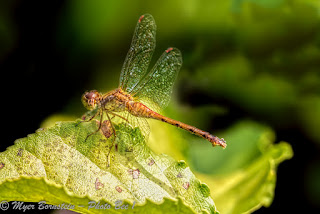Returning from photographing the sunrise yesterday, after downloading and preparing yesterday's blog, we went out to do a little bit more photography at Tamarac Park. One reason was to see if the snapping turtles hatched yet. No, they have not hatched, I am hoping they will hatch before I leave next week for Costa Rica.
In the kiosk at Tamarac, they have posted my print of Dragonflies and Damselflies of Tamarac Park.
As we were checking out the meadow, I came across a leopard frog. First picture shows how they hide and why it may be hard to see them. The second picture is of the leopard frog as it jumped more into the open. I remember that leopard frogs scientific name used to be Rana pipiens, but after going online, it turned out that it scientific name has been changed to Lithobates pipiens. First interesting fact.
 |
| Why Leopard Frogs May Be Hard to Find |
 |
| Leopard Frog in the Open |
Walking down toward the marsh, a blue butterfly fluttered around and first landed on my shoe. It then landed on a leaf. Here comes a second interesting fact. Early in the spring, if we saw this butterfly it would be called a spring azure. Now late in the summer we call them summer azure. Now, if you Google summer azure and depending on which article or site you read, the scientific name of the spring and summer azure are the same or they are different. Even the entomologists have a difficulty making up their mind. One thing is certain the spring azure scientific name is Celastrina ladon. Now the summer azure scientific name could be either Celastrina ladon or Celastrina neglecta. Other folks feel they are all part of the same complex. No matter what, they are a beautiful butterfly to observe and photograph.
 |
| Summer Azure |
 |
| Summer Azure |
Ruby Meadowhawk Dragonfly - Sympetrum rubicundulum are another interesting species. There is some Odontologists who believe that there are three forms, and they should be called Jane's Meadowhawk. The males of the Ruby Meadowhawk have a bright red abdomen with black marks on it while the females and immature males have a yellow abdomen that becomes drab olive-brown or dull reddish in older females. I did find an older female that showed the dull reddish color and in a second view what was interesting was there a tiny loper caterpillar on its tail.
 |
| Female Ruby Meadowhawk |
 |
| Female Ruby Meadowhawk with Caterpillar on Tail |
Remember, always keep learning.
Using the coupon code mborn you will receive a 15% discount on any or all of the Topaz plug-ins.

Help Support my blog by purchasing from Amazon. Clicking on this link and utilizing the link does not cost you anything.
BUY FROM AMAZON









No comments:
Post a Comment